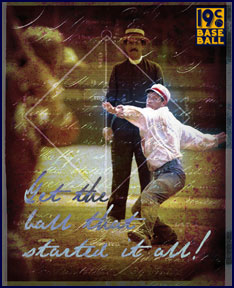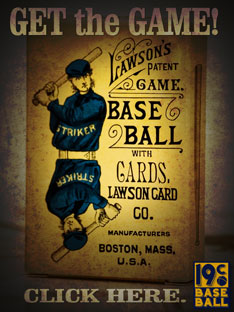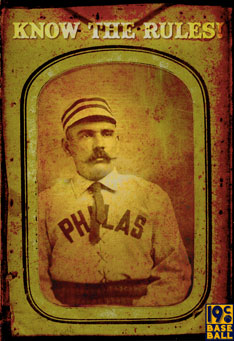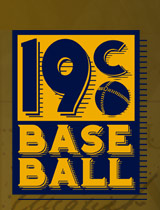Advancing on Foul and Fair Batted Balls (Continued)
Defining Fair and Foul and Advancing on Fair Batted Balls Caught on the Fly

he 1863 rules printed in Beadle's Dime Base-Ball Player, 1864 book, (there was no printing of the 1863 edition but the 1864 rules were exactly the same as the 1863 rules) elaborated further on the base running rules and Section 16 became Section's 17 and 18. The rules were written as follows:
"Sec. 17. No ace nor base can be made upon a foul ball; such a ball shall be considered dead, and not in play until it shall first have been settled in the hands of the pitcher. In such cases players running bases shall return to them, and may be put out in so returning in the same manner as the striker when running to the first base."
"Sec. 18. No ace or base can be made when a fair ball has been caught without having touched the ground; such a ball shall be considered alive and in play. In such cases players running bases shall return to them, and may be put out in so returning, in the same manner as the striker when running to first base; but players, when balls are so caught, may run their bases immediately after the ball has been settled in the hands of the player catching it."
Henry Chadwick's narrative for the above rules was written as follows;
"It will be seen by the above two Sections that a player running a base on a foul ball must return to the base he has left and remain on it until the ball has been fairly settled in the hands of the pitcher. But in case of fly-catches, a player running a base is only required to return and touch the base, after which he can leave it at once and try and make the next base. He must, however, touch the base after the ball has been caught."
There were no changes to the rule regarding a foul batted ball. This explanation, along with the written rule, covered all aspects of a foul batted ball. Technically after a foul batted ball the play does not begin again until the pitcher has the ball and the base runners are standing on their bases. Only then can a base runner attempt to make the next base.
Base runners were allowed for the first time to advance on fair batted balls caught on the fly. This would not change and is still the rule today.
Clarification
The foul ball rule seems to be very hard for current 19th century clubs and players to understand. An experienced club or more specifically an experienced pitcher is able to obtain an out when a runner has run on a foul batted ball.
The following example explains the 1863 base running rule on a foul batted ball and illustrates how to put a runner out.
With a runner on first a ball is batted foul and the left fielder quickly retrieves the ball. The runner on first has started to run toward second base, but hears the yelling of his teammates to return to first. In order for this runner to be put out by the fielding team the ball must first pass through the hands of the pitcher, in any part of the field and then to the player covering first base, which could be the pitcher. The left fielder throws the ball to the pitcher who then makes a bad throw, possibly on purpose, that goes over the player's head who is covering first, as the runner is getting, sliding in most cases, back to the base.
Two things have not happened at the same time in order to allow the runner to advance. 1 - The pitcher did not have the ball when, 2 - The base runner was touching first base. Generally the base runner either sees the ball go past the fielder or his teammates are yelling that the ball got away. The base runner takes off for second base and beyond as the fielding team retrieves the ball.
In order to put that same runner out the ball has to be brought to first base and any player only needs to touch the base. The base runner could also be touched with the ball but he is most likely rounding the bases.
An experienced pitcher will throw the ball past the player covering first base and attempt to bait the runner into thinking he can advance.
The National Association of Professional Base Ball Players
When the National Association, America's first professional baseball league, began play in 1871, the same fair and foul ball rules that the NABBP used in 1870 was adopted. Prior to the NA's second season the position of the pitcher receiving the ball before attempting to put base runners out on foul batted balls was defined, although already known. It stated that the ball must be "settled in the hands of the pitcher, in any part of the field he may happen to be." This was always assumed and made clearer in 1867 when the rules defined that the pitcher was required to receive or move between the pitcher's lines before attempting to put any base runner out when the ball was stopped by a fielder with his hat or cap or stopped or taken from a person not involved in the game. Prior to 1867, the pitcher was not required to be within the Pitcher's lines before attempting to retire base runners for the above reasons.
The National League of Professional Base Ball Clubs
When the National League began play in 1876, the advancement of base runners on fair batted balls caught on the fly that the National Association used during its existence was also adopted. The new league did allow base runners to advance on foul batted balls caught on the fly if the base was held or retouched after the ball was "caught or momentarily held." Base runners were not allowed to advance on a foul batted ball that was not caught on the fly and were allowed to return to their original base without being put out. Base runners were required to remain on their original base until the Pitcher held the ball, which restarted the next play.
The 1880s
Beginning in 1880, all base runners were required to return to the base they started from after a foul batted ball was not caught on the fly, provided they did so "on the run." If the umpire felt that they were not running back to the base, the runner could be put out. This was accomplished by the ball being delivered to the Pitcher and then he, while standing in the Pitcher's box, throwing to the base the runner originated from.
The rule was changed for the 1881 season and the Pitcher did not have to be inside the Pitcher's box when attempting to put out base runners after a foul batted ball struck the ground, if the base runners were not running back to their original bases.
1886 was the last season requiring base runners to return to their original bases, on the run, after a foul batted ball struck the ground and remains the rule today.
The American Association of Base Ball Clubs
The AA began play in 1882 and followed the same rules on foul batted balls that struck the ground as the National League did in 1881 and continued until the 1886 season.
Both the National League and the American Association began following the same rules for the 1887 season and did so until 1891. Beginning in 1887, their was no penalty for base runners who did not run back to their original base after a foul batted ball hit the ground and were allowed a "free" return.
The Rules: 1864 National Association of Base-Ball Players
The Rules of the Game: A Compilation of the Rules of Baseball 1845–1900 ![]()




